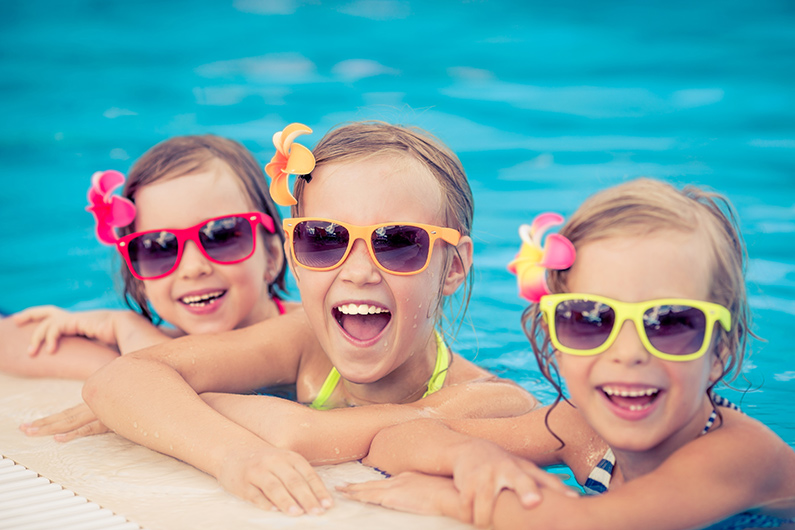A 5 Step Checklist to Making Sure Your Children Are Safe Around the Pool

Having a pool in the backyard is the dream of many Australian families. Families have all kinds of wonderful memories of summer swims and having a little bit of paradise in the home.
For families with young children, however, it’s vital to be very careful about safety and the pool. It’s not enough just to have a fence and a secure gate, although it is critical that you do and that its meets council pool regulations. It’s also important to reinforce to your children what it means to be safe around the pool, and what their responsibilities are.
Make sure your children are always supervised
There should always be an adult supervising children while they’re in the pool, and whoever is supervising should do so without distractions. When there are multiple adults at home (for example, at a family gathering or party), if the children are using the pool, it’s a good idea to rotate the supervisory role, perhaps in 15 minute blocks, so that the adults themselves are less likely to be distracted.
For the children, make sure that they know they should never be using the pool without adult supervision. Again, it’s not enough to simply have a gate on the pool; that will keep toddlers out, but older children can definitely work out how to open the gate. Often, a child that has been having swimming lessons will feel confident enough to swim by themselves, but accidents can still happen, and for a young child, swimming lessons won’t necessarily help if they fall into the pool or injure themselves in the water in some way.
Teach kids basic swimming skills
Though you shouldn’t allow children to swim unsupervised, you should make sure that they know some basic swimming techniques. These include:
- Allowing water to come over their heads (by stepping or jumping into the pool), and then resurfacing
- Floating or treading water for at least one minute
- Turning a full circle in the water, and identify an exit to the pool
- Be able to swim to the exit of the pool from the middle of it
- Exit the pool; including without a ladder or steps.
Make sure the child practices these skills while under adult supervision. Let them use the pool regularly, and have these basic techniques part of the ‘warm-up’ before they can start playing in the water.
Make sure the child knows how to be safe from the sun
Skin diseases from the Australian sun, especially melanomas and other cancers, are a real danger, and a child’s skin is especially susceptible to damage from UV rays. It’s important that the child knows the basic sun safety rules, and can apply them, even without you needing to ask them to beforehand.
The basic rules for sun safety are:
- Wear protective clothing; a good shirt and shorts over bathers is a good idea for playing in the pool
- High UV protection sunscreen (at the very least 30+), reapplied regularly, as it washes off in the water
- A hat and sunglasses; these might not work so well in the pool, but should certainly be put on immediately after getting out of the water.
Young children can be taught these rules from a very young age, so reinforce how important it is every time they use the pool.
Make sure the child knows how to use the pool responsibly
The obvious one here, and the one that parents will almost always tell their children, is not to run around the edge of the pool. Make sure your child knows why; the risk of slipping and hurting themselves, or falling into the water, is significant.
Additionally, one of the biggest risks is that children don’t realise that being in a pool is relatively high-impact exercise, and they are exerting energy and sweating while doing so. Meanwhile, the water from the pool is not being absorbed into the body at nearly the same rate. As ‘wet’ as they’ll feel, the reality is that dehydration is a real risk while swimming for prolonged periods.
So, ensure that children know not to use the pool for extended periods of time, or at least to regularly get out of the water to rehydrate.
When the gate is closed, it stays closed
A child might be able to open the gate to the pool themselves once they reach a certain age. At that point, it can be difficult to supervise them at all times if they’re just going to access the pool whenever they feel like it.
Make the gate one of the most important rules in the family; if it’s closed, your kids must ask your permission to open it. While there’s always the risk that the child will be naughty and disregard this request, most young children will abide their parent’s most important rules – at least, until they’re old enough to know how to swim competently. SP Screens Aluminium Slat gates are custom made to council requirements and to your specifications. The look modern and will maintain a safe entrance to your pool area.
Keeping safe in the pool
Being safe within the family pool isn’t a scary process, and the risks of having a pool and young children, when managed properly, are negligible enough that they shouldn’t put you off installing one. Just make sure you’ve got a robust slatted fence and slat gate around the pool, and make sure that you educate your children properly on using the pool safely from the outset.



Share